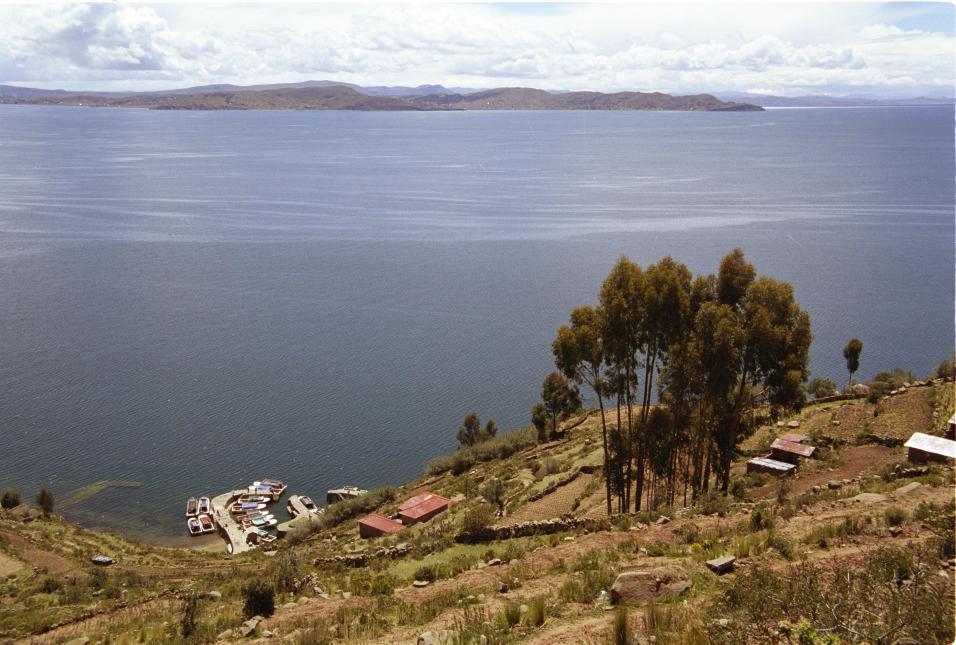22 November 2002: Puno, Peru
Subject: Peru
Sillustani
Our first outing from Puno was to Sillustani, a pre-Inca archaeological site about 40km to the North. It's a group of about sixty tomb-towers, about half a dozen of which are still quite substantial. They say that the Incas didn't invent anything new but just copied the best of all the previous cultures, and the stonework here is certainly up to Inca standards - though it seems to be made from easier-to-work stone than the things in Cusco and Machu Pichu. The towers are built on a peninsular on a lake and there are some quite photgenic views.

On the way back we stopped off at a "traditional country house", a mud-brick place where some locals will show you their kitchen and sell you some souvenirs. It was actually really interesting: they have two different sorts of preserved potatos, and we got to try them with the local cheese or, for the more adventurous, a spoonful of clay!
Finally on the way back to Puno we were treated to a very spectacular thunderstorm with the most enormous flashes of fork-ligtening over Lake Titicaca.
M. N. Yavari
The Yavari is the famous boat that was built in Britain, cut up into more than two thousand pieces, shipped to Peru's Pacific coast and carried up to Titicaca by mule. It's an astonishing story, and the boat ouses history. All the bits have brass plates on saying where they were made - from all corners of the country. We spent an hour or so being shown around by one of the local restorers. Excellent. (Do have a look at the Yavari web site: http://www.yavari.org - I have just learnt that the muleteers who won the contract to carry the bits up to the lake said that they would do it in six MONTHS, not the six YEARS that it actually took!)

Islands of Lake Titicaca
We've spent the last couple of days doing a tour of the islands in the Peruvian end of Lake Titicaca. Of these the best known are the Uros "floating" islands, and we stopped there first for an hour or so.
The bay outside Puno is shallow and full of reeds. The Uros islands are built up from bundles of reeds and are actually quite substantial. The surface is dry and although you do sink in a bit if you stay in the same place for a while it is not the swaying wobbly place you might imagine. Apparently they have a school and health center, and most of the buildings seem to be wooden with corrugated iron rooves. But the bits that the tourists see are all constructed from reeds. You get the impression that these people could build anything at all from reeds! We took a short trip from one island to the next on a reed boat before getting back on our proper boat for the trip to Amantani.
I have chosen a picture that shows some buildings that people actually live in, rather than the tourist places. The "ground" in the background is actually a reed bed and definitely not terra firma.

Amantani, where we spent the night, is a terra firma island beyond Puno Bay in the lake proper. It took about four hours to get there in the most flat-bottomed boat I have ever been in. Looking at the surface of the water you would probably call it "almost calm" - the waves were barely more than a foot in height. But this keel-less thing was rolling all over the place! Not a trip for those prone to sea sickness.
Anyway, we got to spend a couple of hours climbing to the highest point on the island, where there is some sort of temple, before it got dark. There are no hotels on the island and visitors are allocated to a family who feed and house them. The guidebook warned us to expect "three meals of remarkable similarity" and indeed we got vegetable soup, potatos and cheese, rice and chips, and deep fried egg white. Then in the evening we were treated to some local entertainment: a cacophony of pan pipes, guitar, drums, and a very squeeky recorder. Apparently if we had stayed later we would have got to join in some dancing, but it was too much well before that...
Then this morning we crossed - in much calmer conditions, thankfully - to Taquile. Taquile is closer to Puno and a bit more touristy, but still there isn't much to do there apart from walk around looking at the view of the lake and visiting the craft cooperative. Both islands have places where the locals sell their knitting and weaving. In fact on Taquile, almost everyone seemed to be spinning or knitting just about all the time! Although we've seen women in traditional dress in most of Peru, on Taquile it seems to be normal for the men too. They have a tradition of wearing a hat with a white top until they marry when it is replaced by a red patterned one. So you won't be surprised to hear that we didn't escape without making a few purchases...

So this is our last night in Puno, and our last in Peru. Tommorrow we're taking the bus to Copacabana on the Bolivian side of the lake.